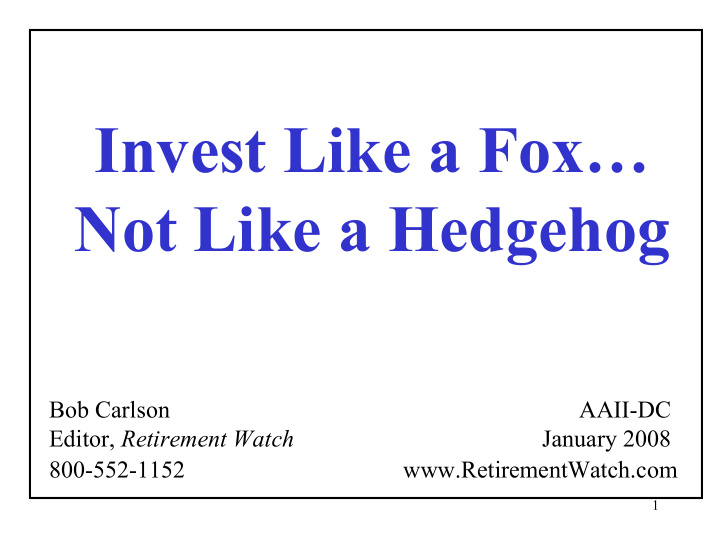



Invest Like a Fox… Not Like a Hedgehog Bob Carlson AAII-DC Editor, Retirement Watch January 2008 800-552-1152 www.RetirementWatch.com 1
Foxes vs. Hedgehogs “The fox knows many things, but the hedgehog knows one big thing.” Archilochus, 7 th century BCE From Isaiah Berlin 2
Foxes Are… • Skeptical of big, central principles • Wary of simple historical analogies • Less likely to be swept away in their own rhetoric • Worried about judging the past too harshly 3
Foxes… • See more value in keeping passions under wraps • Make efforts to integrate conflicting beliefs, theories, and observations 4
Hedgehogs Always Believe in: The Pursuit of the ONE BIG THING 5
Hedgehogs Always Believe: The most dangerous words in the English language are: “It’s different this time.” 6
Point of Maximum Risk Euphoric I'm so It's just a Worried smart. Thrilled correction. Optimistic Anxious Excited Denial Hopeful Optimistic Scared Relieved Hopeful Depressed Desperate How did this happen? Panicked Point of Maximum Opportunity 7
180 160 140 120 100 80 60 40 SPDR ETF 20 0 1/3/2000 5/3/2000 9/3/2000 1/3/2001 5/3/2001 9/3/2001 1/3/2002 5/3/2002 9/3/2002 1/3/2003 5/3/2003 9/3/2003 1/3/2004 5/3/2004 9/3/2004 1/3/2005 5/3/2005 9/3/2005 1/3/2006 5/3/2006 9/3/2006 1/3/2007 5/3/2007 9/3/2007 1/3/2008 8
Questions Hedgehogs Cannot Answer Why are prices of investments more volatile than fundamentals? • Why do stock prices change without a change in fundamentals? Why does the equity risk premium exist? 9
Reasons Questions Are Not Answered Returns in shorter periods differ from long-term average returns Correlations and volatility change Volatility is not risk to most investors Long-term bull and bear markets are not explained 10
Return Portfolios on the Efficient Frontier Areas of Non- Efficient Portfolios The Efficient Frontier Risk 11
Correlations Change 12
Modern Portfolio Theory Risk is as important as return Risk of a portfolio is more important than risk of assets True diversification reduces risk Forecasting is essential to risk reduction and efficiency 13
What Foxes Believe Markets are not always efficient and rational. They are dynamic. Investors make mistakes. Endogenous risk is significant. Markets can reach extreme valuations. Investors must act on forecasts. 14
Investing as Risk Management • MPT says risk as important as returns Make forecasts Consider probability of error Reduce or eliminate unwanted risks Contingency plans Monitor and adjust 15
Relative Returns vs. Absolute Returns Traditional strategy measures against index Should measure against probability of achieving goals Return pattern different from indexes, not dependent on them 16
What To Do Now Investors should seek: Absolute returns, more predictable returns Reduced risk, volatility Low correlation with major market indexes—True Diversification 17
Ways to Manage Risk • Add asset classes • Rebalance more frequently • Use value managers • Manage asset allocation • Use unconventional strategies • All-Weather Strategy • Hedge or use hedge funds 18
Indicators That Have Failed • Dividend yield Price to book value Price-earnings ratio q ratio Technical analysis Extra-market factors 19
What Not to Do—Why Indicators Fail Random events ≠ cause and effect Too many variables Fat tails: The unexpected happens End points affect results Correlation never is 100% Markets are dynamic Turning points obvious only in hindsight 20
Where Are We Now? Unique Financial Markets: Interest rates already low Credit and borrowing crisis Global growth supporting U.S. Housing problems isolated? Inflation still not contained 21
2001 or 2002? 160 140 120 100 80 60 SPDR ETF 40 20 0 1/3/2000 3/3/2000 5/3/2000 7/3/2000 9/3/2000 1/3/2001 3/3/2001 5/3/2001 7/3/2001 9/3/2001 1/3/2002 3/3/2002 5/3/2002 7/3/2002 9/3/2002 1/3/2003 3/3/2003 11/3/2000 11/3/2001 11/3/2002 22
Time to Bottom Fish? • Weakening labor market • Soft mortgage applications • Record profit margins • 21 of 27 measures turned negative • Export growth is slowing • Signs of weakness in Europe • Gradual deterioration of economy 23
Why Disasters Don’t Happen • Diverse, service-oriented economy • Regulators, investors aware of problem • Globalization, with weak linkages • Sectors not as correlated • Wealth effects are lagged 24
Recommend
More recommend